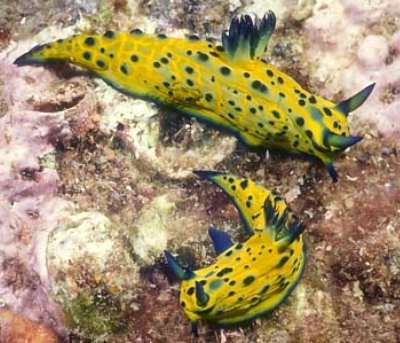
Tambja? gratiosa
(Bergh, 1890)
Order: NUDIBRANCHIA
Suborder: DORIDINA
Superfamily: ANADORIDOIDEA
Family: Polyceridae
Subfamily: Nembrothinae
DISTRIBUTION
Known only from Key West Florida
PHOTO
Moorehead City, North Carolina, USA. Atlantic Ocean. Depth: 55 feet. Length: 2 inches. 1992 shipwreck. Photographer: Herb Segars
In Bergh's original description of Nembrotha gratiosa he notes that the colour information is of the living animal. He notes that the background colour is yellow with blue-black spots, the rhinophores are blue-black above and yellow below, and the gills are yellow below with blue-black edges. He also describes the edge of foot with blue black line, and the sole of the foot as yellow [rough translation of the German]. The specimen was collected from the Dry Tortugas, off Key West, Florida.
A photo [see Herb Segar's message #14281] from North Carolina matches this description. There is also a photo on Mike Miller's website, of what is surely this species, [see message #11625]. That photo, from Carol and Bob Cox, was of a small specimen, probably about 1/2 inch long. It was found and photographed on a sponge on a natural limestone reef about 4 miles out of the Destin, Pass, Destin, NW Florida, Gulf of Mexico.
As I mentioned earlier, one problem I cannot resolve is the generic position of this species. Bergh's anatomical description includes radular drawings showing a cuspless median tooth and a large bicuspid inner lateral tooth which are typical of a species of Tambja. Burn (1967), on the basis of this radular description placed this species in the genus Tambja, a decision follwed by all subsequent workers. However now that we have photos of the live animal it is clear that it has long rolled oral tentacles which are particularly obvious on the Cox photo. The head of species of Tambja is quite different, with a pair of plate-like lappets, rather than elongate tentacles, flanking the mouth. There are good photos of this on the Forum [T. morosa - #10513; T. olivaria - #12539]. The only genus with large enrolled oral tentacles like this is Roboastra [see Roboastra gracilis].
So on oral tentacles this is a species of Roboastra, but on radular anatomy it is a species Tambja. Clearly this can only be resolved by dissecting a specimen. One real possiblity is that the radula that Bergh described belonged to a species of Tambja which had been eaten by the Roboastra. Stranger mistakes have occurred in the history of nudibranch taxonomy. I guess we should call it Tambja? gratiosa until the morphology of its radula can be re-examined.
See discussion [#14292] on its similarity to Tambja stegosauriformis.
- Bergh, L. S. R. (1890): Report on the nudibranchs. Report on the results of dredging, under the supervision of Alexander Agassiz, in the Gulf of Mexico (1877-1878) and in the Caribbean Sea (1879-1880), by the U.S. Coast Survey steamer "Blake", Lleut.-Commander C. D. Sigsbee, U.S.N., and Commander J. R. Bartlett, U.S.N., commanding. 19(3), 155-181 Pls.1-3. [172-5, Pl.2 figs 1-5. Pl.3 figs 1-4]
- Burn, R.F. (1967): Notes on an overlooked nudibranch genus Roboastra Bergh 1877, and two allied genera (Mollusca: Gastropoda). Australian Zoologist, 14: 212-221.
- Pola, M.P., Cervera, J. L. & Gosliner, T.M. (2005). A new species of Tambja (Nudibranchia: Polyceridae: Nembrothinae) from southern Brazil. Journal of the Marine Biological Association, U.K., 85, 979-984.
Rudman, W.B., 2005 (July 19) Tambja? gratiosa (Bergh, 1890). [In] Sea Slug Forum. Australian Museum, Sydney. Available from http://www.seaslugforum.net/find/tambgrat
Related messages
Re: Tambja? gratiosa from NW Florida
August 10, 2005
From: Dev Clifford
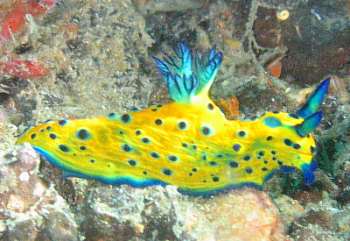
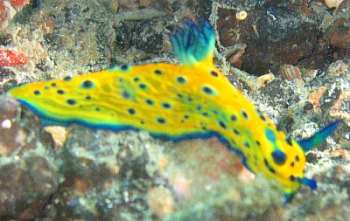
Three weeks ago, on the same wreck where Mr. Segars got his photo of Tambja? gratiosa ten years ago, I found a number of these pretty yellow slugs [see message #14281 ]. My photos aren't nearly as nice as the others here, but I thought it might still be worthwhile to speak up.
Locality: Wreck of the Caribsea, off Cape Lookout, North Carolina, USA,
Atlantic. Depth: 90 feet. Length: 1.5 inches. 26 July 2005. Vertical encrusted side of shipwreck. Photographer: Devereaux Clifford.
Best regards,
Dev Clifford
cliff4@optonline.net
Clifford, D.A., 2005 (Aug 10) Re: Tambja? gratiosa from NW Florida. [Message in] Sea Slug Forum. Australian Museum, Sydney. Available from http://www.seaslugforum.net/find/14519Dear Dev,
Thanks for the information. It is certainly a valuable addition to our knowledge. Interestingly a new species of Tambja has recently been described - Tambja tentaculata Pola, Cervera & Gosliner, 2005 - which has unique, long tentacular oral tentacles, so perhaps your animal is another Tambja with long oral tentacles, rather than a Roboastra, but we will need to look at its anatomy to be sure.
Best wishes,
Bill Rudman
Tambja? gratiosa from NW Florida
July 22, 2005
From: Carol Cox
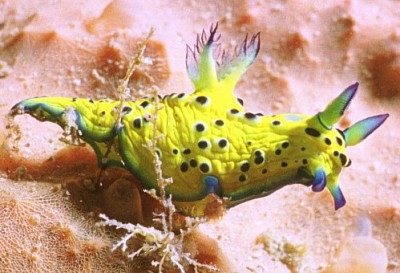
Dr Rudman,
You are welcome to use my photo mentioned in your earlier message [#14292]. It's very similar to the NC slug [#14281 ] but I'm not convinced it's the same; however, I'll leave that up to you experts. The slug I photographed has white circles around the larger blue spots. I realize that is not always an indicator of species; the slug was only about 1/2 inch long, so maybe it was a juvenile and hadn't grown into it's mature coloration. We have moved down the coast about 75 miles, and although that is a short distance away, the bottom structure here is very different with no natural reefs. We haven't been able to locate another one of these slugs for identification.
Locality: Found and photographed on a sponge on a natural limestone reef about 4 miles out of the Destin Pass, Destin, NW Florida, Gulf of Mexico. About 1/2 inch long Photo: Carol Cox
Thanks,
Carol Cox
ccox@mchsi.com
Cox, C., 2005 (Jul 22) Tambja? gratiosa from NW Florida. [Message in] Sea Slug Forum. Australian Museum, Sydney. Available from http://www.seaslugforum.net/find/14312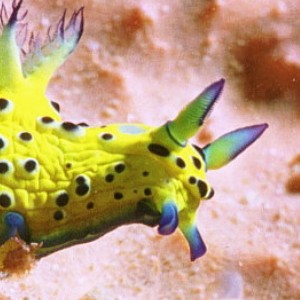
Dear Carol,
Thanks very much for the photo. You are right to mention the white rings around the blue spots, but the spots are the tips of pustules, and the white 'rings' are the basal part of the pustules. In the Nth Carolina animals the basal part of the pustules are a translucent dirty yellow. All things are possible, but I would think the difference is 'within species' variation. What your photo shows very clearly is the nature of the oral tentacles. Their elongate and enrolled structure is found, until now, only in the genus Roboastra. As I said before this does not sit well with Bergh' description of the radula teeth.
Best wishes,
Bill Rudman
Re: Tambja gratiosa? from North Carolina
July 21, 2005
From: Ray Simpson
Hey, this species [message #14281] kind of resembles the mystery polycerid from Mike Miller's site: http://slugsite.us/bow/cox_11a.jpg
They call it a Roboastra and the body shape and placement of gills/oral tentacles/rhinophores is the same... interesting since this individual was photographed in the Gulf of Mexico...
Ray
P51MustNB@aol.com
Simpson, R., 2005 (Jul 21) Re: Tambja gratiosa? from North Carolina. [Message in] Sea Slug Forum. Australian Museum, Sydney. Available from http://www.seaslugforum.net/find/14291Dear Ray,
I discussed this animal some time ago on the Forum [11625 ]. I am pretty sure it is the same species and both certainly fit the external dscription of Nembrotha gratiosa which I discuss in a separate message [#14292 ].
The photo on Mike Miller's site is of a very small specimen, probably about 1/2 inch long. It was photographed by Carol and Bob Cox at the location where it was found, on a sponge located on a natural limestone reef about 4 miles out of the Destin Pass, Key West Florida, very near to where Bergh's original specimen was collected.
Best wishes,
Bill Rudman
The identity of Nembrotha gratiosa
July 21, 2005
From: Bill Rudman
Since posting Herb Segar's photo [#14281] from North Carolina I have checked on Bergh's original description of Nembrotha gratiosa which has confirmed my feelings that this is the same species. Fortunately this was one of the few occasions where Bergh specifically noted that the colour information he provided was of the living animal. He notes that the background colour is yellow with numerous round or oval small grey-green spots [0.6 - 0.8 mm in diameter]. The rhinophores are grey-green above and yellow below, and the gills are yellow below with grey-green edges. He also describes the edge of foot with blackish grey-green line, and the sole of the foot as yellow [rough translation of the German].
I discussed a photo on Mike Miller's website, of what is surely this species, some time ago on the Forum [#11625]. That photo, from Carol and Bob Cox, was of a small specimen, probably about 1/2 inch long. It was found and photographed on a sponge on a natural limestone reef about 4 miles out of the Destin, Pass, Destin, NW Florida, Gulf of Mexico.
As I mentioned earlier, one problem I have is resolving the generic position of this species. Bergh's anatomical description includes radular drawings showing a cuspless median tooth and a large bicuspid inner lateral tooth which are typical of a species of Tambja. Burn (1967), on the basis of this radular description, placed this species in the genus Tambja, a decision followed by all subsequent workers. However now that we have photos of the live animal it is clear that it has long rolled oral tentacles which are particularly obvious on the Cox photo. The head of species of Tambja is quite different, with a pair of plate-like lappets, rather than elongate tentacles, flanking the mouth. There are good photos of this on the Forum [T. morosa - #10513; T. olivaria - #12539]. The only genus with large enrolled oral tentacles like this is Roboastra [see Roboastra gracilis ].
For awhile I wondered whether the recently described Tambja stegosauriformis was actually Nembrotha gratiosa, as its colour is similar, and its radular morphology is identical, to Bergh's description. However Bergh specifically described many small spots, rather than the few large spots found in T. stegosauriformis, and he mentions yellow on the gills and rhinophores. In T. stegosauriformis there is no sign of yellow (or orange) on either the gills or rhinophores.
On oral tentacles this is a species of Roboastra, but from Bergh's description, the radular anatomy is of a species Tambja. Clearly this can only be resolved by dissecting a specimen. One real possiblity is that the radula that Bergh described belonged to a species of Tambja which had been eaten by the Roboastra. Stranger mistakes have occurred in the history of nudibranch taxonomy. I guess we should call it Tambja? gratiosa until the morphology of its radula can be re-examined.
-
Bergh, L. S. R. (1890): Report on the nudibranchs. Report on the results of dredging, under the supervision of Alexander Agassiz, in the Gulf of Mexico (1877-1878) and in the Caribbean Sea (1879-1880), by the U.S. Coast Survey steamer "Blake", Lleut.-Commander C. D. Sigsbee, U.S.N., and Commander J. R. Bartlett, U.S.N., commanding. 19(3), 155-181 Pls.1-3. [172-5, Pl.2 figs 1-5. Pl.3 figs 1-4]
- Burn, R.F. (1967): Notes on an overlooked nudibranch genus Roboastra Bergh 1877, and two allied genera (Mollusca: Gastropoda). Australian Zoologist, 14: 212-221.
- Pola, M.P., Cervera, J. L. & Gosliner, T.M. (2005). A new species of Tambja (Nudibranchia: Polyceridae: Nembrothinae) from southern Brazil. Journal of the Marine Biological Association, U.K., 85, 979-984.
Bill Rudman
Rudman, W.B., 2005 (Jul 21) The identity of Nembrotha gratiosa. [Message in] Sea Slug Forum. Australian Museum, Sydney. Available from http://www.seaslugforum.net/find/14292Tambja gratiosa? from North Carolina
July 19, 2005
From: Herb Segars

I photographed this pair of nudibranchs more than ten years ago off the coast of North Carolina on a shipwreck named the Caribe Sea. I am new to your forum and I really would like to id them. Are they Hypselodoris edenticulata.
Locality: Moorehead City, North Carolina, USA. Atlantic Ocean. Depth: 55 feet. Length: 2 inches. 1992 shipwreck. Photographer: Herb Segars
Thanks for your help.
Herb Segars
hsegars@gotosnapshot.com
Segars, Herb, 2005 (Jul 19) Tambja gratiosa? from North Carolina. [Message in] Sea Slug Forum. Australian Museum, Sydney. Available from http://www.seaslugforum.net/find/14281Dear Herb,
This is an interesting find - although 10 years in coming to light. It is not a Hypselodoris but rather a polycerid nudibranch. It could belong to Nembrotha, Tambja or Roboastra, but to be sure what genus your animals belong to we would really need to look at their internal anatomy. Two species have been described from the western Atlantic and it could possibly be Nembrotha gratiosa Bergh, 1890, but he didn't give enough data on the external colour to be sure. In a very recent paper, Marta Pola and others [2005] mention that 'Tambja gratiosa is light yellowish with random round grey-green spots on the back and sides' so it is possible that is the identity of your animal. Hopefully Marta will let us know. My only doubt is the very long oral tentacles we can see in your photo, which remind me more of a Roboastra than a Tambja.
-
Pola, M.P., Cervera, J. L. & Gosliner, T.M. (2005). A new species of Tambja (Nudibranchia: Polyceridae: Nembrothinae) from southern Brazil. Journal of the Marine Biological Association, U.K., 85, 979-984.
Best wishes,
Bill Rudman
Roboastra sp. from Gulf of Mexico
December 10, 2003
From: Ray Simpson
On Mike Miller's slug site there is a picture ... http://slugsite.us/bow/nudwk121.htm
It shows a yellow sea slug with blue spots that they call a Roboastra, from the Gulf of Mexico. Can you put a name on this species?
As for the genus, Malacolog database shows no Roboastra slugs in the W. Atlantic ... now there is a species from Brazil [Roboastra sp. 1], one here from the Gulf, and one from Venezuela in Humann's book. I guess the Caribbean is very poorly studied for such beautiful slugs to go unnoticed ...
Thanks
Ray Simpson
P51MustNB@aol.com
Simpson, R., 2003 (Dec 10) Roboastra sp. from Gulf of Mexico. [Message in] Sea Slug Forum. Australian Museum, Sydney. Available from http://www.seaslugforum.net/find/11625Dear Ray,
The spectacular nudibranch on Mike Miller's site certainly looks like a species of Roboastra from the long rolled oral tentacles. I have not seen another photo or published description of it. The animal in Humann's book [2nd ed 2002: p. 309] is probably a species of Tambja or perhaps Nembrotha, rather than Roboastra but that is just a guess on my part. As you say, we still have a lot to learn about the western Atlantic and the Caribbean. I guess I'm biased, but when you think that nearby Cape Canaveral is the site of man's probably most expensive search for knowledge, trillions of dollars being spent to get rocks from the Moon and the planets. Wouldn't it be nice if a tiny fraction of that could be diverted to study the unknown life in the sea alongside.
Best wishes
Bill Rudman
